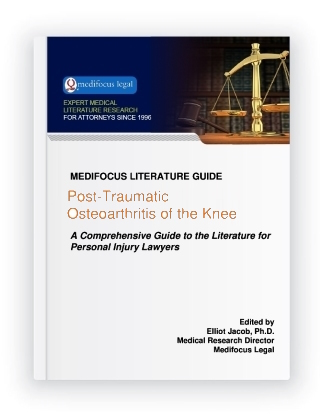Post-Traumatic Osteoarthritis of the KneeA Comprehensive Guide to the Literature for Personal Injury Lawyers
Publisher: Medifocus Legal
Publication Date: January 16, 2023
Number of Pages: 134
A Comprehensive Guide to the Literature for Personal Injury Lawyers
Publisher: Medifocus LegalPublication Date: January 16, 2023
Number of Pages: 134
Several important factors have been identified that increase a person's risk for developing osteoarthritis. These risk factors include: older age, obesity, female gender, genetics, repeated stress on a joint, and joint trauma. Injuries to a joint from sports or an accident is a well-recognized risk factor for a particular type of osteoarthritis called posttraumatic osteoarthritis. Even injuries that occurred years in the past and seemingly healed, can increase the risk of posttraumatic osteoarthritis.
Although osteoarthritis can affect any joint in the body, one of the areas most commonly affected is the knee joint. An estimated 13 million adults in the U.S. over the age of 60 have radiographic evidence of knee osteoarthritis. It's estimated that posttraumatic osteoarthritis accounts for approximately 10% of all osteoarthritis cases.
Among all knee injuries, approximately 50% involve either the meniscus or the anterrior cruciate ligament (ACL). Both meniscal and ACL injuries carry a high risk for developing posttraumatic osteoarthritis. In fact, it's estimated that individuals who sustain a knee injury are more that 4 times more likely to develop osteoarthritis than those without a history of knee injury.
Conservative treatments such as pain medications and physical/occupational therapy are considered as the initial approach to patients with knee osteoarthritis. Patients who fail to adequately respond to conservative treatments may require more invasive procedures such as cortisone or lubricating injections. A subset of knee osteoarthritis patients will require major surgery that may include an osteotomy to realign the damaged bones or total knee replacement. In calculating the damages for an acute knee injury case, attorneys need to keep in mind the increased risk to their client for developing posttraumatic osteoarthritis and the potential additional future medical expenses associated with additional treatments that may be necessary. As an example, the estimated average total knee replacement surgery cost in the United States is $32,570.
The MediFocus Literature Guide to Post-Traumatic Osteoarthritis of the Knee is a comprehensive reference guide to the literature that is designed to provide personal injury lawyers with a detailed overview of the current state of medical knowledge about posttraumatic knee osteoarthritis.The hand-selected articles included in the Guide cover all major aspects of posttraumatic osteoarthritis including the risk factors, treatments, expected outcomes, and impact on health-related quality of life. This objective is accomplished by a comprehensive review of the peer-reviewed literature published over the past two decades as documented from individual case reports, cohort studies, meta-analysis, and major topical review articles.
 |
- A comprehensive bibliography of 169 journal article references indexed in MEDLINE published in well respected medical and scientific journals.
- Online access to the abstracts (summaries) of the articles.
- Online access to the free full-text version of 97 articles.
- Links to full-text sources of other articles that are available for purchase directly from individual journal publishers.
- A unique "Author Directory" consisting of the names and institutional affiliations of experts who have published and have specialized knowledge about Post-Traumatic Osteoarthritis of the Knee. The "Author Directory" is a valuable resource for quickly identifying and locating experts for case reviews, opinions, and testimony.
Select examples of topics that are covered by the articles referenced in this Guidebook include:
- Risk factors for knee osteoarthritis after traumatic knee injury.
- The Relationship Between Pain and Quality of Life Among Adults With Knee Osteoarthritis
- Association between disease progression and depression onset in persons with radiographic knee osteoarthritis.
- The Clinical Radiographic Incidence of Posttraumatic Osteoarthritis 10 Years After Anterior Cruciate Ligament Reconstruction
- An Evidence-Based Systematic Review of Human Knee Post-Traumatic Osteoarthritis
- Knee osteoarthritis and its association with mental health and health-related quality of life
- Depression and Pain in Asian and White Americans With Knee Osteoarthritis.
- Radiographic and Symptomatic Knee Osteoarthritis 32 to 37 Years After Acute Anterior Cruciate Ligament Rupture.
- Lingering risk: A meta-analysis of outcomes following primary total knee arthroplasty for patients with post-traumatic arthritis.
- Post-traumatic osteoarthritis following ACL injury.
- Post-traumatic osteoarthritis diagnosed within 5 years following ACL reconstruction.
- Patient-Reported Outcome Measures of Total Knee Arthroplasties for Post-Traumatic Arthritis versus Osteoarthritis
- Risk of post-traumatic knee osteoarthritis after knee injury in military service members.
- Ten-year survival and complications of total knee arthroplasty for osteoarthritis secondary to trauma or surgery
- Predicting knee osteoarthritis risk in injured populations.
- Revision of Total Knee Arthroplasties Performed in Young, Active Patients with Posttraumatic Arthritis and Osteoarthritis.
- Morphologic and quantitative magnetic resonance imaging of knee articular cartilage for the assessment of post-traumatic osteoarthritis.
- Projecting Lifetime Risk of Symptomatic Knee Osteoarthritis and Total Knee Replacement in Individuals Sustaining a Complete Anterior Cruciate Ligament Tear in Early Adulthood.
- Does Age Influence the Risk of Incident Knee Osteoarthritis After a Traumatic Anterior Cruciate Ligament Injury?
- Posttraumatic Total Knee Arthroplasty Continues to Have Worse Outcome Than Total Knee Arthroplasty for Osteoarthritis.
is available in two formats: | |
Order by Phone:To order by phone, please call: Order by Mail:To order by mail, please print and complete this Order Form | |

